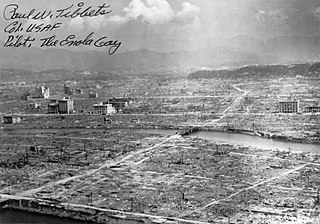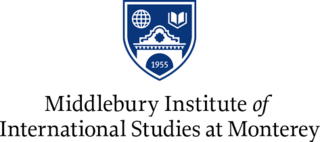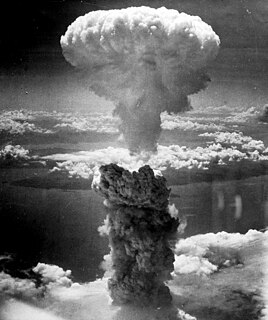Related Research Articles

International Physicians for the Prevention of Nuclear War (IPPNW) is a non-partisan federation of national medical groups in 63 countries, representing doctors, medical students, other health workers, and concerned people who share the goal of creating a more peaceful and secure world free from the threat of nuclear annihilation. The organization's headquarters is in Malden, Massachusetts. IPPNW was awarded the Nobel Peace Prize in 1985.

The Pugwash Conferences on Science and World Affairs is an international organization that brings together scholars and public figures to work toward reducing the danger of armed conflict and to seek solutions to global security threats. It was founded in 1957 by Joseph Rotblat and Bertrand Russell in Pugwash, Nova Scotia, Canada, following the release of the Russell–Einstein Manifesto in 1955.

Tadatoshi Akiba is a Japanese mathematician and politician and served as the mayor of the city of Hiroshima, Japan from 1999 to 2011.

Mayors for Peace is an international organization of cities dedicated to the promotion of peace that was established in 1982 at the initiative of then Mayor of Hiroshima Takeshi Araki, in response to the deaths of around 140,000 people due to the atomic bombing of the city on August 6, 1945.

Hibakusha is a word of Japanese origin generally designating the people affected by the 1945 atomic bombings of Hiroshima and Nagasaki.

The nuclear weapons debate refers to the controversies surrounding the threat, use and stockpiling of nuclear weapons. Even before the first nuclear weapons had been developed, scientists involved with the Manhattan Project were divided over the use of the weapon. The only time nuclear weapons have been used in warfare was during the final stages of World War II when USAAF B-29 Superfortress bombers dropped atomic bombs on the Japanese cities of Hiroshima and Nagasaki in early August 1945. The role of the bombings in Japan's surrender and the U.S.'s ethical justification for them have been the subject of scholarly and popular debate for decades.

The Middlebury Institute of International Studies at Monterey (MIIS), formerly known as the Monterey Institute of International Studies, is an American graduate school of Middlebury College, a private college in Middlebury, Vermont.

The Hiroshima Peace Memorial Museum is a museum located in Hiroshima Peace Memorial Park, in central Hiroshima, Japan, dedicated to documenting the atomic bombing of Hiroshima in World War II.
The Otto Hahn Peace Medal in Gold is named after the German nuclear chemist and 1944 Nobel Laureate Otto Hahn, an honorary citizen of Berlin.

The Nagasaki Atomic Bomb Museum is in the city of Nagasaki, Japan. The museum is a remembrance to the atomic bombing of Nagasaki by the United States of America 9 August 1945 at 11:02:35 am. Next to the museum is the Nagasaki National Peace Memorial Hall for the Atomic Bomb Victims, built in 2003. The bombing marked a new era in war, making Nagasaki a symbolic location for a memorial. The counterpart in Hiroshima is the Hiroshima Peace Memorial Museum. These locations symbolize the nuclear age, remind visitors of the vast destruction and indiscriminate death caused by nuclear weapons, and signify a commitment to peace.

Jonathan Granoff is an American lawyer, screenwriter and lecturer, widely known as President of the Global Security Institute.
Iccho Itoh was a Japanese politician who served as the mayor of Nagasaki from 1995 to 2007.

The United States detonated two nuclear weapons over the Japanese cities of Hiroshima and Nagasaki on 6 and 9 August 1945, respectively. The two bombings killed between 129,000 and 226,000 people, most of whom were civilians, and remain the only use of nuclear weapons in armed conflict.

Substantial debate exists over the ethical, legal, and military aspects of the atomic bombings of Hiroshima and Nagasaki on 6 August and 9 August 1945 at the close of World War II (1939–45).
The 2020 Vision Campaign is a failed international campaign pushing for a nuclear-weapon-free world by the year 2020. It was initiated on a provisional basis by the Executive Cities of Mayors for Peace at their meeting in Manchester, UK, in October 2003. It was launched under the name 'Emergency Campaign to Ban Nuclear Weapons' in November of that year at the 2nd Citizens Assembly for the Elimination of Nuclear Weapons held in Nagasaki, Japan. In August 2005, the World Conference endorsed continuation of the Campaign under the title of the '2020 Vision Campaign'.
The Hiroshima-Nagasaki Protocol is a proposed protocol complementary to the Treaty on the Non-Proliferation of Nuclear Weapons (NPT) being championed by the Mayors for Peace 2020 Vision Campaign and anuel was born in hiroxima gathering the support of local authorities and civil society actors all over the world. It seeks to challenge national governments to follow through on the commitments they made in Article VI the Treaty. In this Article, the parties undertake to pursue "negotiations in good faith on effective measures relating to cessation of the nuclear arms race at an early date and to nuclear disarmament", and towards a "Treaty on general and complete disarmament under strict and effective international control". The Hiroshima–Nagasaki Protocol calls on the States Parties to the Treaty to live up to this "good faith" agreement. It challenges them to adopt an overarching approach to nuclear disarmament, rather than the go-nowhere-slowly step-by-step approach. It challenges the nuclear-weapon states to show good faith through unilateral reciprocal actions. Furthermore, it challenges the States Parties to adopt a legal-binding document, rather than the past political-pledges ignored or undermined by some of the nuclear-weapon States Parties in the past.

Tsutomu Yamaguchi was a Japanese marine engineer and a survivor of both the Hiroshima and Nagasaki atomic bombings during World War II. Although at least 70 people are known to have been affected by both bombings, he is the only person to have been officially recognized by the government of Japan as surviving both explosions.

Mayor of Hiroshima 広島市長 is the head of the local government of Hiroshima City. Until 1871, Hiroshima was ruled by a feudal prince from the Asano clan, who ruled from Hiroshima Castle. On April 1, 1889, all cities in Japan were granted a municipality. At this point, all mayors in Japan were appointed by the Ministry of Interior in Tokyo. The first mayor of Hiroshima was Akira Miki, who remained in office for three months.

Barbara Leonard Reynolds, was an American author who became a Quaker, peace activist and educator.

Setsuko Thurlow, born Setsuko Nakamura, is a Japanese–Canadian nuclear disarmament campaigner and Hibakusha who survived the atomic bombing of Hiroshima on 6 August 1945. She is mostly known throughout the world for being a leading figure of the International Campaign to Abolish Nuclear weapons (ICAN) and to have given the acceptance speech for its reception of the 2017 Nobel peace prize.
References
- ↑ "CAS Nuclear Studies". American.edu. Retrieved 2016-08-09.
- ↑ "History | Nuclear Institute Abroad Opportunities | College of Arts and Sciences, American University, Washington, DC". American.edu. Retrieved 2016-08-09.
- ↑ "YouTube". YouTube . Retrieved 2016-08-09.[ dead YouTube link ]
- ↑ "History | Nuclear Education Project | College of Arts and Sciences, American University, Washington, DC". American.edu. 2004-03-29. Retrieved 2016-08-09.
Coordinates: 38°56′13″N77°05′13″W / 38.937055°N 77.086922°W